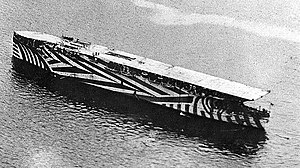
Back Аргус (самолетоносач) Bulgarian HMS Argus (I49) Czech Argus (Schiff, 1918) German HMS Argus (I49) Spanish اچاماس آرگوس (آی۴۹) Persian HMS Argus (I49) Finnish HMS Argus (I49) French HMS Argus (I49) Italian アーガス (空母) Japanese HMS 아거스 (I49) Korean
 Argus in harbour in 1918, painted in dazzle camouflage
| |
| History | |
|---|---|
| Name | Argus |
| Namesake | Argus Panoptes |
| Builder | William Beardmore, Dalmuir |
| Yard number | 519 |
| Identification | Pennant number: I49 |
| Nickname(s) |
|
| Laid down | 1914 |
| Acquired | September 1916 |
| Launched | 2 December 1917 |
| Commissioned | 16 September 1918 |
| Decommissioned | About 1929 |
| Recommissioned | 30 July 1938 |
| Reclassified | As accommodation ship, December 1944 |
| Fate | Sold for scrap, 5 December 1946 |
| General characteristics (as built) | |
| Type | Aircraft carrier |
| Displacement | 14,450 long tons (14,680 t) (standard load) |
| Length | 565 ft (172.2 m) (o/a) |
| Beam | 68 ft (20.7 m) |
| Draught | 23 ft 3 in (7.1 m) (deep load) |
| Installed power |
|
| Propulsion | 4 × shafts; 4 × steam turbines |
| Speed | 20 knots (37 km/h; 23 mph) |
| Range | 3,600 nmi (6,700 km; 4,100 mi) at 10 knots (19 km/h; 12 mph) |
| Complement | 495 |
| Armament |
|
| Aircraft carried | 15–18 |
HMS Argus was a British aircraft carrier that served in the Royal Navy from 1918 to 1944. She was converted from an ocean liner that was under construction when the First World War began and became the first aircraft carrier with a full-length flight deck that allowed wheeled aircraft to take off and land. After commissioning, the ship was involved for several years in the development of the optimum design for other aircraft carriers. Argus also evaluated various types of arresting gear, general procedures needed to operate a number of aircraft in concert and fleet tactics. The ship was too top-heavy as originally built, and had to be modified to improve her stability in the mid-1920s. She spent one brief deployment on the China Station in the late 1920s before being placed in reserve for budgetary reasons.
Argus was recommissioned and partially modernised shortly before the Second World War and served as a training ship for deck-landing practice until June 1940. The following month she made the first of her many ferry trips to the Western Mediterranean to fly off fighters to Malta; she was largely occupied in this task for the next two years. The ship also delivered aircraft to Murmansk, Russia, Takoradi in the Gold Coast, and Reykjavík, Iceland. By 1942, the Royal Navy was very short of aircraft carriers, and Argus was pressed into front-line service despite her lack of speed and armament. In June, she participated in Operation Harpoon, providing air cover for the Malta-bound convoy. In November, the ship provided air cover during Operation Torch, the invasion of French North Africa, and was slightly damaged by a bomb. After returning to the UK for repairs, Argus was used again for deck-landing practice until late September 1944. In December, she became an accommodation ship, and was listed for disposal in mid-1946. The ship was sold in late 1946 and scrapped the following year.